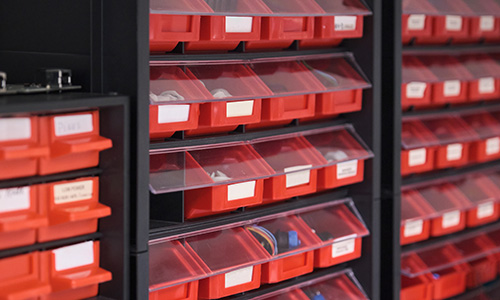Workbench Organization Ideas to Try Today
Is your workbench a junk magnet? From pegboards to storage ideas, our guide gets your workspace into project mode.

How to Organize Your Workbench for Your Best Productivity
So you're cleaning out your garage, and you've made it to the workbench. What the heck happened to your hammer? Where are those four crescent wrenches that seem to have disappeared from your set?
If you’re a diehard DIYer, your workbench is probably overflowing with tools, and finding anything is an ordeal. Wouldn’t you rather just grab the tool you need, right when you need it?
We’ve got your back. We’ll show you how to organize your workshop and keep it that way, from tips on pegboard organization to tool storage ideas.
Let’s get started.

Put Your Pegboard to Good Use
Pegboard is the tried and true workbench organization solution. Not only does it save you space on the table itself, but it makes the most of an area that you wouldn't otherwise get to use. Plus, it lets you quickly scan your work area to ensure that the tools are where they should be.

Pro Tip
If you don’t already have a pegboard, buy one with 1/4 inch-diameter holes — called "large hole pegboards." With this type, you'll have the option to hang heavier tools with larger, sturdier hooks.
9 Tools to Consider Hanging on Your Pegboard
While your pegboard is ideal for a range of tools, here are the most common ones you'll see hanging on the wall:
- Pliers
- Prybars
- Hammers
- Wrenches
- Hand saws
- Screwdrivers
- Extension cords
- Large levels and rulers
- Anything frequently used
5 Workbench Pegboard Ideas
So, now that you know what tools go on your board, it’s time to get them all in order. These pegboard organization ideas make it simple to keep your workbench ship-shape.
- Put the tools you use most often at eye-level where they’re easiest to grab.
- Place your next most-used tools toward the bottom of the board and the tools you use least at the top.
- Group similar tools in the same section of the board and arrange them by size. It’ll be instantly clear which tools go where when you’re done working.
- Hang duplicates on the same peg to save room. Better yet — donate or toss the extras.
- Leave enough space between pegs to remove the tool you need without knocking others down.
Don’t Be Afraid to Get Creative
- Install pegboard shelves to hold jars or tools that are difficult to hang.
- Use binder clips to hang a pocket organizer or tool pouch for things like brushes, zip ties and other miscellaneous objects.
- Attach tape and wire spools to carabiners and slip the clips over a dowel rod. You won’t have to slide everything off the rod to get what you need.
- Slide a length of PVC pipe over a peg and use the open space to organize and store extension cords, rope, bungie cords etc.

Pro Tip
To test different layouts, make a square the same size as your pegboard with masking tape. Rearrange your tools inside it until you find the system that works best.

Take Your Workbench Tool Storage to the Next Level
Wall storage is nice, but it won't completely clear up your workbench. Larger, heavier tools, as well as hardware like nails, screws and washers, all need homes too. That's where table-top organization comes in handy.
10 Steps for Better Workbench Tool Organization
- Decide how much workspace you really need. Do you want plenty of room for cutting and tinkering? Or is your workbench mainly for storage?
- Add a few inches to your work station as a buffer and tape off the area. Don’t forget to leave room for permanent features like a grinder or vice.
- Use tin cans or glass jars to hold nails, bolts, nuts and other small objects. Simple and thrifty, it’s a classic for a reason!
- Line up the jars or cans you use most often along the back of your bench across from your work area. Use a spice rack or other stackable organizer if you’re short on room.
- Use another stackable organizer to corral jars filled with infrequently used hardware at the end of your bench.
- Store power tools and their accessories in workbench drawers. If you don’t have built-in drawers, use plastic or metal ones.
- Use any remaining drawers to store hand tools that wouldn’t fit on your pegboard.
- Glue short pieces of PVC pipe to your workbench in an easily accessible area to organize pencils, markers, rulers, levels and similar objects.
- Attach tool aprons or pocket organizers to the front or sides of your bench if you still need more storage. Just make sure they won’t get in the way of opening any drawers.
- Store materials like motor oil, lighter fluid and WD-40 underneath your workbench. If there’s room, put them in milk crates you can easily slide out to grab what you need.
Working on decluttering more than just your workbench? Check out our complete home decluttering guide for tips and tricks to tackle any spot in your house.

Keep in Mind
Put a stepstool next to your workbench so you can quickly get to any tools stored out of your reach.
Workbench Organization FAQs
What do you put in a workbench drawer?
Smaller drawers are ideal for hardware, pens, pencils, markers and smaller items, particularly if you can insert a partition or an organizing tray. Larger, deeper drawers are perfect for bulky tools that are used less often or tools that you don't want easily visible.
How can I organize my workbench?
Organizing a workbench is simple if you have the space and storage items needed. Pegboard is a fantastic way to hang tools above your workbench, while storage jars, baskets and shelves on and around the workbench also do wonders to clear space.
How do you set up a workbench?
Organization is key when setting up a workbench. Take the time to map out your drawers and available hanging space so you can accurately plan on where your tools, hardware and other supplies will go. Consider taping out an area on the floor that matches your space to test out which storage configurations will work best for you.
Get Back to Work With a Clutter-Free Space
With these workbench organization tips, you can whip your workshop into shape in no time. Then, you can look forward to spending your weekends DIYing like a well-oiled machine.
What Do You Think?
How did your workbench cleaning go? We're listening. Head over to Twitter or Facebook,
and use #dumpstersblog to join the conversation.







